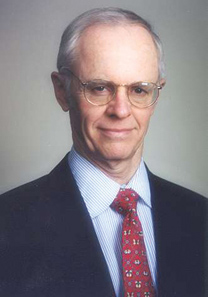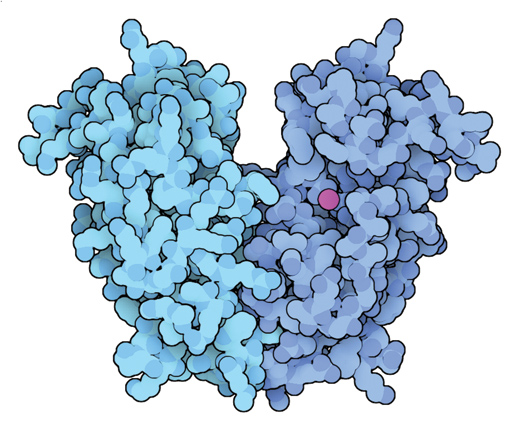
for Structural Bioinformatics Protein Data Bank
Summer
2008
Number 38
| PDB
COMMUNITY FOCUS
John Norvell, Ph.D., Program Director, National Institute of General Medical Sciences Q: How did your research training prepare you for your career at the National Institutes of Health (NIH)? A: My graduate field was physics and I studied magnetic materials. I learned the principles of crystallography and came to realize that my main scientific interests were somewhere between physics and biology. Subsequent research in biophysics and protein/tRNA crystallography got me hooked on structural biology. I have now worked at the National Institute of General Medical Sciences (NIGMS) for 30 years and, although I am not in a research lab, my knowledge of this field is important almost every day. Q: How do you view your relationship with the resources that you fund, such as the RCSB PDB and the Protein Structure Initiative? A: As a NIGMS program director for these resources, my main responsibility is to ensure that the scientific community--and ultimately the broader public--receive the maximum benefit from these funded resources. The issues are usually complicated, and there are seldom easy answers. But I enjoy solving problems, the wide variety of the work, the interaction with many groups (federal staff, resource scientists, advisors, scientists, etc.), and the overall NIGMS/NIH mission. As you know, the RCSB PDB is supported by a consortium of ederal agencies headed by the National Science Foundation. I find managing the support of resources to be challenging, invigorating, and rewarding. Q: In addition to supporting research, you also administer the NIGMS Predoctoral Institutional Training Grants--what are your goals for training future scientists? A: These training grants support multidisciplinary graduate training programs and students all over the country. Although these training grants make only a small contribution to the total support for graduate students in the biomedical sciences, they are important because they focus on the highest quality graduate programs and students. The goal of these training grants is to promote multidisciplinary activities to prepare students for research careers. The NIGMS training grants include core courses, lab rotations, seminars, training in the responsible conduct of research, journal clubs, research retreats, etc. The NIH requires all these programs to recruit students from groups that are underrepresented in the biomedical sciences. The NIGMS training grant program has evolved with time and several new areas such as computational biology and bioinformatics have been added. I anticipate that the program will continue to change and promote even better graduate education and lead to a better national research effort with many benefits to the public. Q: Structural genomics is focused on solving as many structures as possible in a short period of time. Since the year 2000, the Protein Structure Initiative (PSI) has determined more than 3000 structures, and developed new methods and technologies. How has this changed structural biology? Q: The PSI Structural Genomics Knowledgebase (SGKB) makes the products of the PSI--the structures, methodologies, target information--available from an integrated website (kb.psi-structuralgenomics.org). Who do you envision will use this tool? What types of research can it enable? A: The PSI SGKB will bring together the resources developed by the PSI centers so that researchers across biomedical fields can access data, tools, materials, methods, and structures that will help them advance their own studies. Structure has only slowly been incorporated into the general scientific toolkit, and as several structural biologists have remarked, this is a cultural problem that must be corrected. Structure is so powerful that it should become a major tool for the broad scientific community. Q: How will community input, in terms of annotations and target suggestions, impact the PSI centers and the PSI SGKB "marketplace of ideas"? A: A major goal of the PSI and the PSI SGKB is to involve the broader scientific community in the PSI. The PSI is now at the end of the third year of the second 5-year phase and it is imperative to accelerate this process. Our focus right now is on making the products of the PSI easily available and known to the scientific community and to involve non-structural biologists in target selection decisions. I am confident that the PSI SGKB will play a dramatic role in making this happen.
NIGMS: www.nigms.nih.gov
Image of RNase T from an article by David S. Goodsell from
the PSI SG Knowledgebase |
E-mail: info@rcsb.org • Web: www.pdb.org • FTP: ftp.wwpdb.org
The RCSB PDB is a member of the wwPDB (www.wwpdb.org)

 A: When we first considered the PSI in 1999, it was not clear that a structural genomics pipeline could be built. The development of many new techniques and methods and the now widespread utilization of robotics have automated many of the steps of producing and determining the structure of many new proteins and has improved both efficiency and success rates. In addition, the RCSB PDB has worked with the centers to improve the automation of structural deposition. I believe the PSI centers have played a major role in this transformation. Many new tools and methods developed in part by the PSI centers are now in labs around the world.
A: When we first considered the PSI in 1999, it was not clear that a structural genomics pipeline could be built. The development of many new techniques and methods and the now widespread utilization of robotics have automated many of the steps of producing and determining the structure of many new proteins and has improved both efficiency and success rates. In addition, the RCSB PDB has worked with the centers to improve the automation of structural deposition. I believe the PSI centers have played a major role in this transformation. Many new tools and methods developed in part by the PSI centers are now in labs around the world.
